
Times News Network, ngày 2 tháng 6 năm 2005
Bài của Shona Adhikari,
Aurangabad, Ấn Độ – Nếu bạn nghĩ rằng thời trang chỉ dành cho quần áo thì bạn nhằm rồi. Các hang động tráng lệ Ajanta và Ellora cách thành phố Aurangabad không xa lạ một trong số những địa điểm du lịch được ưa chuộng nhất vào thời gian Ấn Độ giành được độc lập.

Sau đó, số du khách giảm dần mặc dù Aurangabad là một vùng kỷ nghệ chính. Khách tham quan giảm cũng là do không có đủ chuyến bay cho họ từ Delhi hoặc Mumbai đến. Từ thời niên thiếu, sau khi xem những hình ảnh của các điêu khắc trên đá nổi tiếng ở Ajanta, tôi quyết định thăm viếng nơi này ngay khi có cơ hội. Ellora ban đầu không lôi cuốn như là Ajanta, nhưng đó chỉ là nơi trước khi tôi tham quan ngôi đền tuyệt đẹp Kailash cắt từ đá núi.

Cuối cùng thì tôi thực hiện chuyến tham quan ngôi đền vào tháng 7 cách đây vài năm. Tôi khám phá rằng thời kỳ tốt nhất đến thăm Ajanta là vào mùa mưa .
Khi chúng tôi lái xe đến Ajanta, mùa mưa đã bắt đầu, thời tiết không nóng lắm, phải mất 2 tiếng đồng hồ trên những con lộ được tu bổ cẩn thận. Những du khách muốn ở lại qua đêm có thể nghĩ nhà dành cho du khách tại Ajanta, hoặc là trạm xe lửa.

Ajanta có 29 hang động được hình thành vào khoảng 200 năm trước BC cho đến 650 năm AD, hang động được cắt theo dạng hình móng ngựa, khoét sâu vào bên trong vực thẩm núi đá. Sông Beghora chạy qua lòng vực và vào mùa mưa quang cảnh thật là tuyệt đẹp. Các tu sĩ Phật giáo đã đục khoét tạo nên những hang động và không ai biết tới chúng cho đến khi các binh lính Anh quốc tình cờ khám phá vào năm 1819.

Cave 30: Chota (small) Kailasa Temple, Ellora
Do bị bỏ quên như vậy, hang động đã bảo tồn được những bức họa khắc trên tường, tuy nhiên công tác phục hồi cũng bảo vệ vẻ đẹp của chúng. Sau khi thăm viếng những hang động trong ánh sáng lờ mờ (bạn có thể trả tiền để thắp sáng đèn), bạn sẽ thoải mái khi tận mắt xem những điêu khắc trên tường một tài liệu điêu khắc bằng kỷ thuật của Nhật Bản trong một bảo tàng viện nhỏ ngay tại chổ. Mặt ngoài của các hang động có những điêu khắc lộng lẫy hình Đức Phật nhiều dạng và kích thước khác nhau.

Sân trong khu quần thể hang động Ajanta
Bên trong hang động cũng có rất nhiều điêu khắc hình Phật khổng lồ làm cho các tín đồ Phật tử thấy mình rất nhỏ bé khi chiêm ngưỡng. Một bức khắc Đức Phật nằm cực kỳ lớn gây ấn tượng đối với du khách, những ngọn đèn cầm tay phản chiếu thắp sáng mọi nơi của hang động. Tuy nhiên, những quyến rũ chính của những hang động Ajanta là những điêu khắc trên đá và trên tường đẹp tuyệt vời được làm từ các tu sĩ Phật Giáo từ thời xa xưa.
Trong số đó những bức điêu khắc đẹp nhất được thấy ở tại động 17, tại đây người ta thấy có nhiều bức điêu khắc về cuộc sống hằng ngày, các lễ hội hoàng gia, và khán giả được mô tả chi tiết. Bức họa một phu nhân hoàng tộc được các người hầu giúp vận y phục là một trong những bức họa nổi tiếng nhất ở Ajanta.

Những trụ cột được chạm khắc tinh xảo
Từ những bức điêu khắc này, các nhà nghiên cứu có thể biết được những câu chuyện thời kỳ xuất hiện của Ikat nổi tiếng. Các nhân vật hoàng tộc trong các bức khắc họa mặc trang phục “sà rong” mà kiểu mặc trông rất giống như các sà rong ngày nay.
Chuyến thăm viếng Ellora phải thực hiện vào ngày khác vì nó hoàn toàn ở khác hướng. Con đường băng qua pháo đài nổi tiếng nằm ở trên đồi Daulatabad (cách Aurangabad 15km), pháo đài dài giống như là một tảng đá lớn dáng kim tự tháp được xem như không thể chinh phục được.

Pháo đài dài là một việc làm hiện rõ nhất của lịch sử, thời kỳ Mohammd Bin Tughlak, người cai trị kỳ quặc ở Delhi, quyết định dời kinh đô của ông đến đó vào thế kỷ thứ 14.
Trong khi Ellora là mục đích của tôi, tôi dành cho Daulatabad một ngày khác. Ellora chỉ cách Dautalabad một khoảng cách ngắn (cách Aurangabad 30km), nơi đây có 34 hang động được đẻo từ đá bởi nhiều tôn giáo khác nhau. Nó có lẽ là một trong những nơi hòa hợp tinh thần tôn giáo trên thế giới gồm 12 hang động lâu đời nhất của Phật Giáo, 17 của Ấn Độ giáo và 5 còn lại là của Kỳ na giáo.

Những hang động được cắt vào bên trong một ngọn đồi dài khoảng 2 km và phần lớn có những hành lang đi vào phức tạp. Một số hang động có 3 hoặc 2 tầng và một số thậm chí có cả hành lang bên ngoài hang động chưa làm xong, một số khác có những tác phẩm điêu khắc tuyệt vời.

Ngôi đền uy nghi Kailash được các tín đồ thăm viếng tấp nập vào hầu hết là trung tâm hấp dẫn du khách ở Ellora. Đây là thể hiện của nghệ thuật kiến trúc đền thờ cắt từ đá của Ấn Độ đã đạt đến đỉnh cao nhất. Ngôi đền bao gồm một sân rộng 81 mét dài, 47 mét rộng và 33 mét cao. Ở phần chính giữa, ngôi đền chính được xây cao hơn và nối với vòng bên ngoài bằng một cái cầu. Chung quanh vòng rào là hành lang triển lãm, phía trước là hai con voi bằng đá đặt ở bên cửa căn phòng Nandi.

Trong số những hang động của tôn giáo Jain, hành lang thành Indra Sabha là đẹp nhất. Thiết kế trên mặt đất thì giống như ngôi đền Kailash, nhưng phần bên trên có những chạm trổ điêu khắc tuyệt vời. Nhiều hình ảnh thành Tirthankars, Parasnath, và Gomateshwara, chung quanh thành Gomateshwara có vườn thảo mộc và thú vật. Bên trong điện thờ là hình thành Mahavir ngồi, đây là vị thánh Kỳ Na Giáo thứ 24 và là vị Tirthankars cuối cùng.
Những dấu vết của các tranh vẽ phải còn có thể nhìn thấy trên trần nhà và trên tường. Các hang động Phật Giáo có thể được xây bởi những người đã rời bỏ Ajanta vì một lý do không rõ, những hang động này kém lôi cuốn vì khu vực quá rộng và hang động không có tập trung ở một chỗ, phần lớn khách tham quan có khuynh hướng đi thẳng tới đền Kailash.

Described as Cave 16, the Kailasa Temple is considered
the pinnacle of Indian rock-cut architecture
Trên đường về, tôi dừng ở Khuldabad (cũng đưọc gọi là Rauza) để xem bia mộ của vua Urangzeb nằm trong vùng Alamgir Dargah ở trung tâm thành phố. Thật ra không có bia mộ ở đây, chỉ là một nấm mộ đơn sơ. Vì đại đế Mughal này, (Aurangabad được gọi theo tên của ông), đã cai trị vùng rộng lớn nhất của Hindustan vào lúc ông băng hà, được chôn cất trong một nấm mộ trơ trọi và chỉ có một miếng đá hoa dựng đứng ghi tên ông. Điều này để tiếp nối tính keo kiệt mà Aurangzeb đã thực hiện trong suốt cuộc đời của ông. Sau này, người Anh đã xây một hàng rào bằng đá hoa chung quanh nấm mộ.
Thật là một nơi yên nghĩ khiêm tốn và bình yên cho một vị đại đế mà cuộc đời ông đã gây nhiều tranh cãi. Tuy nhiên còn có nơi nào tốt hơn để yên nghĩ mãi mãi bằng nơi hội tụ nhiều đức tin tôn giáo như nơi này. Tôi chắc rằng các thế kỷ qua sẽ chứng minh điều đó.



संस्कृति मंत्रालय के अधीन भारतीय पुरातत्व सर्वेक्षण (भा.पु.स.) राष्ट्र की सांस्कृतिक विरासतों के पुरातत्वीय अनुसंधान तथा संरक्षण के लिए एक प्रमुख संगठन है । भारतीय पुरातत्व सर्वेक्षण का प्रमुख कार्य राष्ट्रीय महत्व के प्राचीन स्मारकों तथा पुरातत्वीय स्थलों और अवशेषों का रखरखाव करना है । इसके अतिरिक्त, प्राचीन संस्मारक तथा पुरातत्वीय स्थल और अवशेष अधिनियम, 1958 के प्रावधानों के अनुसार यह देश में सभी पुरातत्वीय गतिविधियों को विनियमित करता है । यह पुरावशेष तथा बहुमूल्य कलाकृति अधिनियम, 1972 को भी विनियमित करता है ।
भारतीय पुरातत्व सर्वेक्षण प्राचीन संस्मारक तथा पुरातत्वीय स्थल और अवशेष अधिनियम, 1958 के अधीन राष्ट्रीय महत्व के स्मारकों, स्थलों तथा अवशेषों के संरक्षण के संबंध में आपत्तियां, यदि कोई हो, आमंत्रित करते हुए दो महीने का नोटिस देता है । दो माह की निर्दिष्ट अवधि के पश्चात् तथा इस संबंध में आपत्तियां यदि कोई प्राप्त होती है, की छानबीन करने के पश्चात् भारतीय पुरातत्व सर्वेक्षण किसी स्मारक को अपने संरक्षणाधीन लेने का निर्णय करता है
include temples, mosques, tombs, churches, cemeteries, forts, palaces, step-wells, rock-cut caves, and secular architecture as well as ancient mounds and sites which represent the remains of ancient habitation. explore.प्रकाशन
भारतीय पुरातत्व सर्वेक्षण अपने प्रारंभ से ही, दोनों वार्षिक तथा विशेष विषयों के प्रकाशन निकालता है जो पुरालेखीय तथा मुद्रा विषयक के अलावा, उत्खननों में पुरातत्वीय अनुसंधानों, मंदिरों तथा धार्मिक भवनों के अन्वेषणों, संरक्षण, वास्तुशिल्पी सर्वेक्षण से संबंधित होते हैं । इनके अलावा, सर्वेक्षण केन्द्रीय संरक्षित स्मारकों और पुरातत्वीय स्थलों पर लोकप्रिय साहित्य को गाइड बुक, फोल्डर/ब्राशर, फोर्टफोलियो तथा पिक्चर पोस्टकार्ड के रूप में निकालता है ।
PUBLICATIONS
The Archaeological Survey of India brings out a variety of publications since its inception, both annual and special with subject matters ranging from archaeological researches in excavations, explorations, conservation, architectural survey of temples and secular buildings besides epigraphy and numismatics.
पुरातत्व संस्थान
पुरातत्व संस्थान की स्थापना वर्ष 1985 में पुरातत्व, पुरालेख मुद्रा शास्त्र, संग्रहालय विज्ञान, संरक्षण, पुरातत्व विषयक कानून आदि के बहु विषयक क्षेत्र में उन्नत प्रशिक्षण प्रदान करने के लिए 1959 में स्थापित किए गए स्कूल ऑफ आर्किलॉजी का उन्नयन करके की गई थी । संस्थान में चलाए जाने वाला पुरातत्व में स्नातकोत्तर डिप्लोमा दो वर्ष की अवधि का है । यह संस्थान के संकाय सदस्यों तथा गेस्ट लेक्चररों के रूप में देश के प्रसिद्ध पुरातत्वविदों द्वारा चलाया जाता है। >


;INSTITUTE OF ARCHAEOLOGY
imparting advanced training in multidisciplinary field of Archaeology, Epigraphy, Numismatics, Museology, Conservation, Antiquarian law, etc. The Post Graduate Diplomain Archaeology course, conducted in the Institute is of two years duration. Know more about Institute, PGDA & Syllabus etc.>विदेशों में गतिविधियाँ
सर्वेक्षण के पुरात्वीय प्रयास उप महाद्वीप की सीमाओं के बाहर किए गए और विदेशों में इसके सभी अभियान
उत्कृष्ट रहे हैं । ACTIVITIES ABROAD
Archaeological endeavours of the Survey extended beyond the frontiers of the subcontinent and have excelled in all its expeditions abroad. संग्रहालय
भारत में संग्रहालयों की अवधारणा पीछे ऐतिहासिक कालों की मानी जा सकती है जिनमें चित्रशाला (चित्र दीर्घा) के संदर्भों का उल्लेख है । तथापि, भारत में संग्रहालय आन्दोलन का विकास परवर्ती कालों में उसी प्रकार हुआ जिस प्रकार यूरोप में हुआ । ASI MUSEUMS
A separate Museums Branch in ASI was created in 1946 by Mortimer Wheeler. After the independence, there was a spurt in the growth of site museums in ASI. At present there are 41 site museums under the control of ASI. राष्ट्रीय मिशन - स्मारक चिह्न एंव प्राचीन कालीन वस्तु
भारत के पास प्रागैतिहासिक समय से निर्मित विरासत, पुरातत्वीय स्थलों तथा अवशेषों के रूप में असाधारण रूप से मूल्यवान, विस्तृत तथा विविध सांस्कृतिक विरासत हैं । बड़ी संख्या में स्मारक ही उत्साहवर्धक हैं तथा ये सांस्कृतिक विचार तथा विकास दोनों के प्रतीक हैं । अब ऐसा प्रतीत होता है कि भारत की विरासत को संस्थापित करना इसके विद्यमान होने में शासित प्रक्रिया तथा किस तरह यह विरासत लोगों से संबंधित है, के अतीत के हमारे ज्ञान, समझ तथा शायद रुचि में कुछ मूलभूत कमी हुई है जो सांस्कृतिक रूपों में व्यक्त इसके आविर्भाव औद्योगिक वृद्धि के युग में तेजी से बदल रही जीवन शैली में अपनी पारम्परिक महत्ता को खो रहे हैं ।
NATIONAL MISSION on Monuments and Antiquities
India has an extraordinarily rich, vast and diverse cultural heritage in the form of built heritage, archaeological sites and remains since prehistoric times. The sheer magnitude in number alone is overwhelming and these are the symbols of both cultural expression and evolution. Ajanta Caves
AJANTA
Brief Description
The first Buddhist cave monuments at Ajanta date from the 2nd and 1st centuries B.C. During the Gupta period (5th and 6th centuries A.D.), many more richly decorated caves were added to the original group. The paintings and sculptures of Ajanta, considered masterpieces of Buddhist religious art, have had a considerable artistic influence.

The style of Ajanta has exerted a considerable influence in India and elsewhere, extending, in particular, to Java. With its two groups of monuments corresponding to two important moments in Indian history, the Ajanta cave ensemble bears exceptional testimony to the evolution of Indian art, as well as to the determining role of the Buddhist community, intellectual and religious foyers, schools and reception centres in the India of the Gupta and their immediate successors.
The caves are situated 100 km north-east of Ellora, 104 km from Aurangabad and 52 km from Jalgaon Railway Station. They are cut into the volcanic lava of the Deccan in the forest ravines of the Sahyadri Hills and are set in beautiful sylvan surroundings. These magnificent caves containing carvings that depict the life of Buddha, and their carvings and sculptures are considered to be the beginning of classical Indian art.

The 29 caves were excavated beginning around 200 BC, but they were abandoned in AD 650 in favour of Ellora. Five of the caves were temples and 24 were monasteries, thought to have been occupied by some 200 monks and artisans. The Ajanta Caves were gradually forgotten until their 'rediscovery' by a British tiger-hunting party in 1819.

The Ajanta site comprises thirty caves cut into the side of a cliff which rises above a meander in the Waghora River. Today the caves are reached by a road which runs along a terrace mid-way up the cliff, but each cave was once linked by a stairway to the edge of the water. This is a Buddhist community, comprising five sanctuaries or Chaitya-grihas (caves 9, 10, 19, 26 and 29) and monastic complex sangharamas or viharas. A first group of caves was created in the 2nd century BC: the chaitya-grihas open into the rock wall by doorways surmounted by a horse-shoe shaped bay. The ground plan is a basilical one: piers separate the principal nave from the side aisles which join in the apsis to permit the ritual circumambulation behind the (commemorative monument). This rupestral architecture scrupulously reproduces the forms and elements visible in wooden constructions.

A second group of caves was created at a later date, the 5th and 6th centuries AD, during the Gupta and post-Gupta periods. These caves were excavated during the supremacy of the Vakatakas and Guptas. According to inscriptions, Varahadeva, the minister of the Vakataka king, Harishena (c. AD 475-500), dedicated Cave 16 to the Buddhist sangha while Cave 17 was the gift of the prince, a feudatory. An inscription records that the Buddha image in Cave 4 was the gift of some Abhayanandi who hailed from Mathura.
The earlier architectural formulas were re-employed but treated in an infinitely richer and more ample manner. The decoration attained, at this time, an unequalled splendour: the statuary is numerous (it was already permissible to represent Buddha as a human; these representations are found both on the facades and in the interior). Finally, the wall painting, profuse and sensitive, constitutes, no doubt, the most striking artistic achievement of Ajanta.
Under the impulse of the Gupta dynasty, Indian art in effect reached its apogee. The Ajanta Caves are generally decorated with painted or sculpted figures of supple form and classic balance with which the name of the dynasty has remained synonymous. The refined lightness of the decoration, the balance of the compositions, the marvellous beauty of the feminine figures place the paintings of Ajanta among the major achievements of the Gupta and post-Gupta style and confer on them the ranking of a masterpiece of universal pictorial art.

Kailasa Temple, cave #16 at Ellora, India
Full resolution (1,280 × 960 pixels, file size: 545 KB, MIME type: image/jpeg)
It consists of a gateway, antechamber, assembly hall, sanctuary and tower. Virtually every surface is lavishly embellished with symbols and figures from the puranas (sacred Sanskrit poems). The temple is connected to the gallery wall by a bridge.

The gigantic, 8th century Kailasa Temple at Ellora, Cave 16,
was chiselled from solid stone. Click for bigger image


Kailasa Temple, cave #16 at Ellora, India
Dramatic sculptures fill the courtyard and the main temple, which is in the center.
It must have been quite a spectacular sight when it was covered with white plaster and elaborately painted.
Kailasa Temple, cave #16 at Ellora, India
Unlike other caves at Ajanta and Ellora, Kailasa temple has a huge courtyard that is open to the sky,
surrounded by a wall of galleries several stories high.
The Kailasa temple is an illustration of one of those rare occasions when men's minds, hearts, and hands work in unison towards the consummation of a supreme ideal.

Buddhist monks honor an ancient sacred image. Photo © Marc Shandro.
Buddhists worship at the Buddha's feet. Photo
Visitors outside the caves. Photo ©
Ajanta (more properly Ajujnthi), a village in the erstwhile dominions of the Nizam of Hyderabad in India and now in Buldhana district in the state of Maharashtra (N. lat. 20 deg. 32' by E. long. 75 deg. 48') is celebrated for its cave hermitages and halls.
Located 99-km from Aurangabad, Maharashtra, Ajanta encompasses 29 rock-cut rooms created between 200 BC and AD 650 using rudimentary hand tools. Most are viharas (living quarters), while four are chaityas (temples).

The artisans responsible for Ajanta did not just hack holes in the cliff, though. They carefully excavated, carving stairs, benches, screens, columns, sculptures, and other furnishings and decorations as they went, so that these elements remained attached to the resulting floors, ceilings and walls. They also painted patterns and pictures, employing pigments derived from natural, water soluble substances. Their achievements would seem incredible if executed under ideal circumstances, yet they worked only by the light of oil lamps and what little sunshine penetrated cave entrances.

The seventh century abandonment of these masterpieces is a mystery. Perhaps the Buddhists suffered religious persecution. Or perhaps the isolation of the caves made it difficult for the monks to collect sufficient alms for survival. Some sources suggest that remnants of the Ajanta colony relocated to Ellora, a site closer to an important caravan route. There, another series of handcrafted caves chronologically begins where the Ajanta caves end. Ellora Caves Near Ellora , village in E central Maharashtra state, India, extending more than 1.6 km on a hill, are 34 rock and cave temples (5th–13th century). Located about 30 Kilometres from Aurangabad, Ellora caves are known for the genius of their sculptors. It is generally believed that these caves were constructed by the sculptors who moved on from Ajanta. This cave complex is multicultural, as the caves here provide a mix of Buddhist, Hindu and Jain religions. The Buddhist caves came first, about 200 BC - 600 AD followed by the Hindu 500 - 900 AD and Jain 800 - 1000 AD

.Of the 34 caves chiselled into the sloping side of the low hill at Ellora, 12 (dating from AD 600 to 800) are Buddhist (one chaitya, the rest viharas), 17 are Hindu (AD 600 to 900), and 5 are Jain (AD 800 to 1100). As the dates indicate, some caves were fashioned simultaneously - maybe as a form of religious competition. At the time, Buddhism was declining in India and Hinduism regaining ground, so representatives of both were eager to impress potential followers. Although Ellora has more caves than Ajanta, the rooms generally are smaller and simpler (with exception of Kailasa Temple). Visiting Ajanta and Ellora One of India's greatest architectural treasures, the Kailasa temple attracts thousands of tourists annually.

(100 kilometres northeast by road) requires a full-day excursion and Ellora
(30 kilometres northwest) a half-day. Don't Miss:
Khajuraho Temples in India
A renowned Artist of India, has restored and preserved the Indian Heritage of Ajanta painting.
Renowned artist of Marathwada Mr. M.R. Pimpare has for the past 55, Years been trying to recreate the paintings of the Gupta – Vakataka period around 450 A. D. unfolding to the world the actual glory of Ajanta which over the years has suffered deterioration.

The centuries –old paintings of Ajanta caves recreated exactly as they were when freshly painted by the unknown artist recapture the past glory of the wall paintings on gigantic sheets of paper.
Mr.Pimpare has completed 350 paintings which measure from one foot to 65’ x 4’ in length capturing minute details of expression, facial flexion, contours of the body, movement of the muscles and other minute details.


Ajanta art gallery is a display of the restructuring of Ajanta cave paintings. It is a devoted work of 30 long years by Mr. M.R. Pimpare, an artist whose work is done on the basis of photographs and historical records like drawings with all details prepared indicating the extent of damaged portion and contracting it faithfully in colour.

Mr. Pimpare has undertaken an entirely new approach of preservation and conservation as well as restoration of paintings with the help of most scientific modern and sophisticated instruments. The new approach aims at conservation of paintings in its exact duplicate copy form exactly like the original which are displayed in the Art Gallery. It is also proposed by the Marathwada Statutory Development Board to have a permanent art gallery which would provide glimpses of the famous National Heritage.
Ajanta Art Gallery at present is located in Eknath Nagar, Near Shahnoor Miya Dargah.







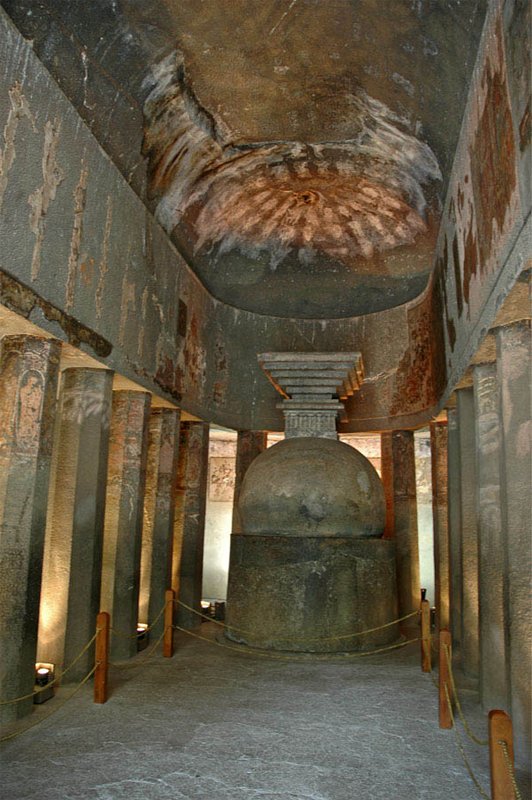
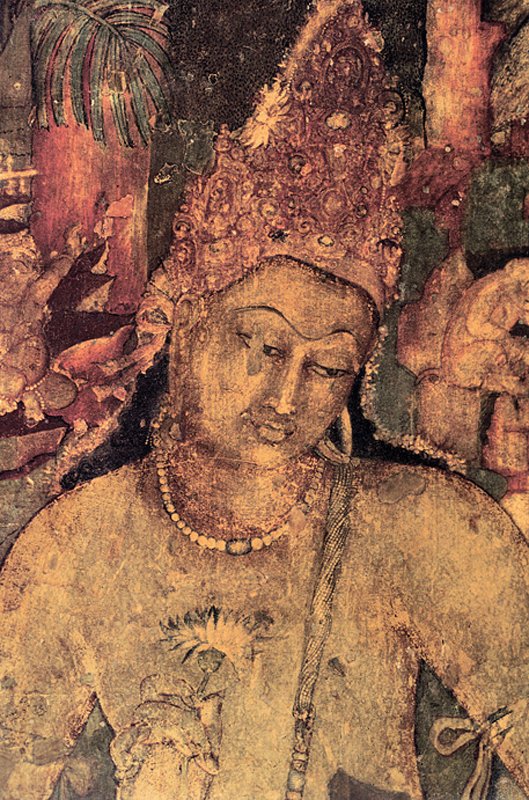
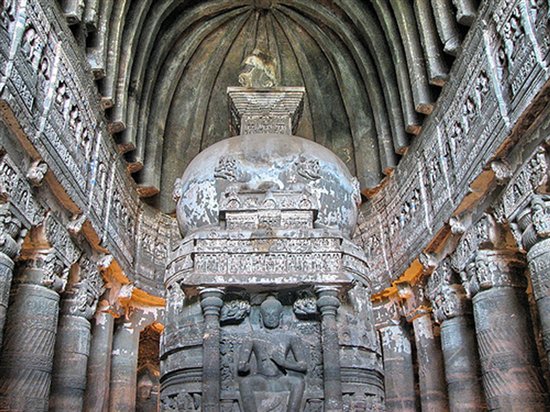
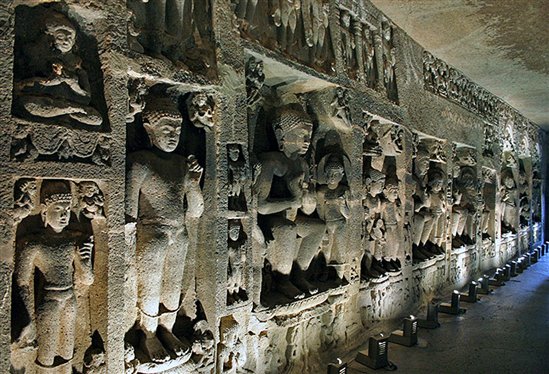
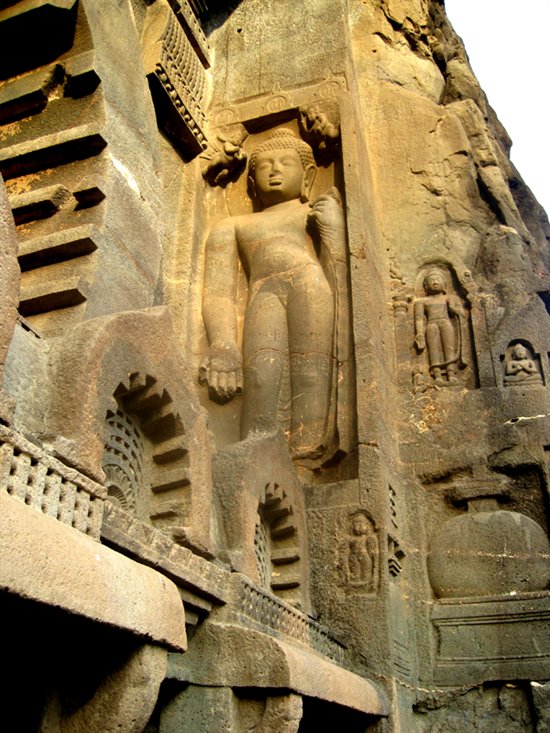
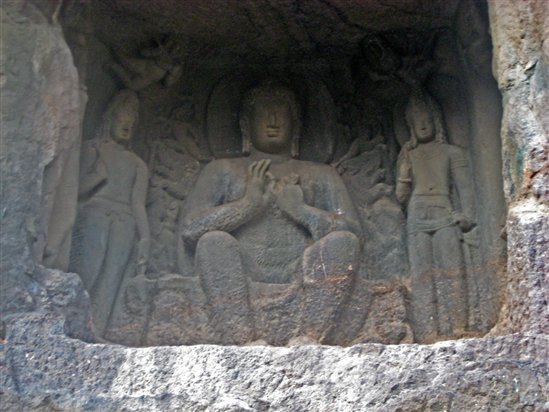









No comments:
Post a Comment